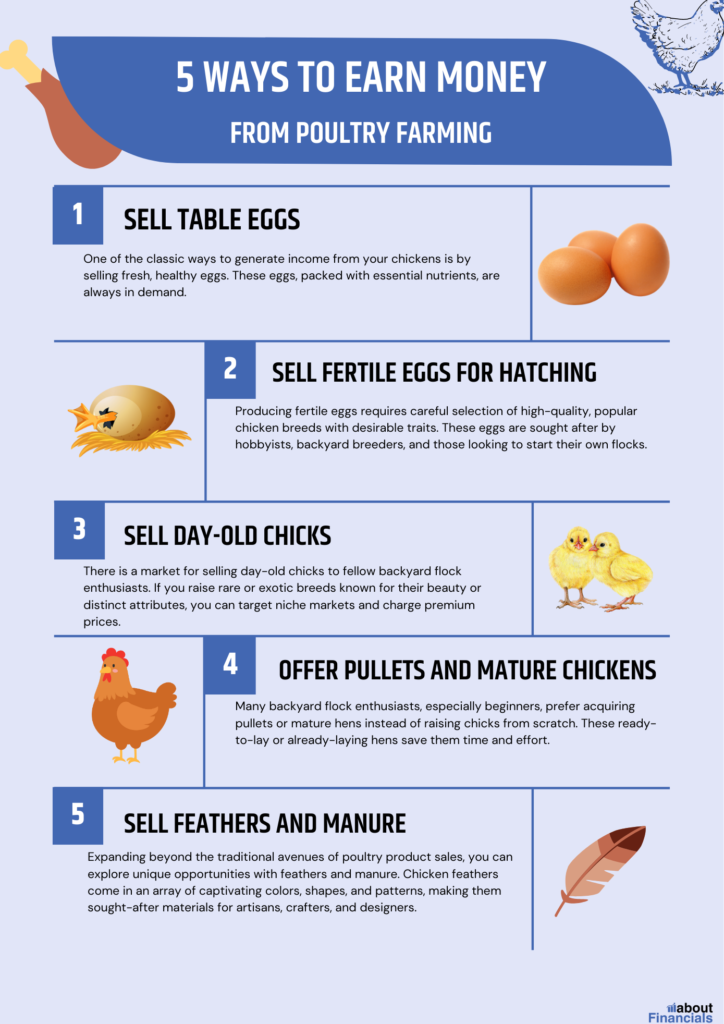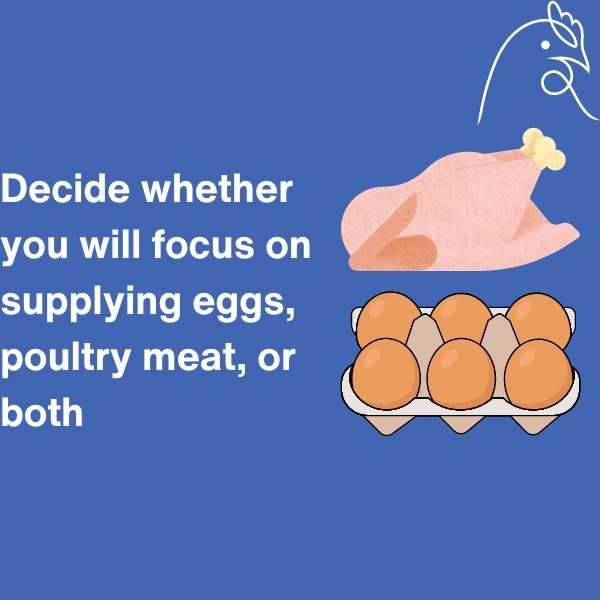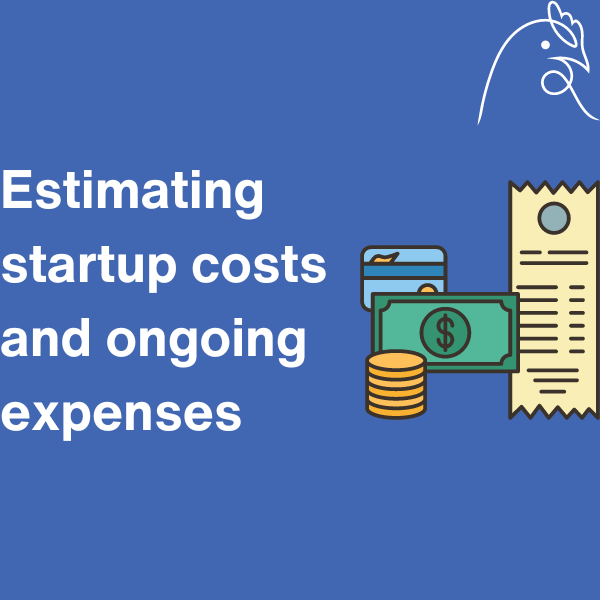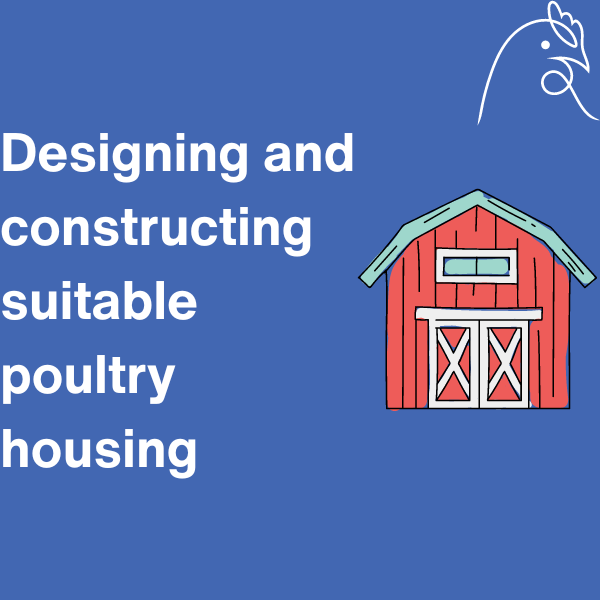Poultry production in the United States has been on a steady upward trajectory, driven by the increasing demand from both domestic and international consumers.
In 2022, the poultry sector experienced a substantial surge in sales, reaching an impressive $76.9 billion—an increase of 67% from the previous year. Broiler sales soared by 60%, turkey sales rose by 21%, and egg sales skyrocketed by 122%. These figures demonstrate the immense potential for profitability in the poultry industry.
Over the past decade, broiler production has seen a remarkable 22% growth, while egg production has risen by 10%. Though turkey production has faced some declines since 2017, the overall trend remains positive due to the thriving broiler sector.
A. Making money from poultry farming – Top 5 ways

1. Offer fresh, nutritious eggs
The total market share of egg production in US is $9.9 billion during 2022.
One of the classic ways to generate income from your chickens is by selling fresh, healthy eggs. These eggs, packed with essential nutrients, are always in demand. Pricing can vary based on factors such as feed expenses, production costs, and the quality of your eggs. Typically, you can set your prices between $3 and $5 per dozen.
For example, you can market your eggs as organic, free-range, or from heritage breeds, appealing to health-conscious customers who appreciate the superior quality and ethical production methods.
2. Provide fertile eggs for hatching
In addition to selling fresh eggs, you can tap into the market for fertile eggs used in hatching.
Producing fertile eggs requires careful selection of high-quality, popular chicken breeds with desirable traits. These eggs are sought after by hobbyists, backyard breeders, and those looking to start their own flocks.
By offering fertile eggs, you provide customers with the opportunity to experience the joy of incubating eggs and witnessing the hatching process. Consider highlighting the unique characteristics of your chicken breeds and the high hatchability rate of your eggs to attract potential buyers.
3. Sell day-old chicks
There is a market for selling day-old chicks to fellow backyard flock enthusiasts.
Pricing for chicks can vary based on factors such as breed popularity and quality. Highly sought-after breeds with specific traits or unique appearances command higher prices compared to common or mixed-breed chicks.
For example, if you raise rare or exotic breeds known for their beauty or distinct attributes, you can target niche markets and charge premium prices. Provide potential buyers with information about the breed’s characteristics, temperament, and suitability for different purposes, such as egg-laying or meat production.
4. Offer pullets and mature chickens
Many backyard flock enthusiasts, especially beginners, prefer acquiring pullets or mature hens instead of raising chicks from scratch. These ready-to-lay or already-laying hens save them time and effort.
The pricing of adult chickens can vary depending on the breed’s quality, productivity, and popularity. Emphasize the benefits of purchasing mature chickens, such as immediate egg production, established health, and reduced waiting time for customers to enjoy farm-fresh eggs.
5. Harness the potential of feathers and manure
Expanding beyond the traditional avenues of poultry product sales, you can explore unique opportunities with feathers and manure. Chicken feathers come in an array of captivating colors, shapes, and patterns, making them sought-after materials for artisans, crafters, and designers.
Making money from poultry farming is not as easy as it may seem. There is a whole system that works behind the scenes to transform your hard work into profits. The following strategies will help you gain a better understanding of the various aspects of poultry farming and ensure that you can generate the maximum yield from your efforts.
B. Understanding the Poultry Market
In order to make money from poultry farming, it is crucial to have a solid understanding of the poultry market. This involves conducting thorough market research, identifying target markets and consumer preferences, as well as analyzing competition and market trends. Let’s delve into each aspect to gain valuable insights and increase your chances of success.
Conducting Market Research

It’s essential to conduct comprehensive market research.
This involves gathering information about the demand for poultry products in your target area. Look for data on population demographics, income levels, dietary preferences, and consumption patterns.
Understanding the market size, growth potential, and seasonal variations will help you make informed decisions about production volumes, pricing, and marketing strategies.
Identifying Target Markets and Consumer Preferences:
Identifying your target market is crucial for effective poultry farming.
Consider whether you will focus on supplying eggs, poultry meat, or both.
Determine if you will cater to individual consumers, restaurants, supermarkets, or other specific market segments.
Research consumer preferences in terms of product quality, packaging, pricing, and organic or free-range options.
By aligning your production with market demands, you can maximize your profitability and customer satisfaction.
Analyzing competition and market trends
Analyzing the competition is a vital step in understanding the poultry market landscape.
Identify existing poultry farms, local suppliers, and major industry players in your area.
Study their offerings, pricing strategies, marketing tactics, and distribution channels.
This analysis will help you identify opportunities for differentiation, such as offering specialty products or focusing on niche markets.
C. Selecting the right poultry species
Evaluating different poultry species
Start by evaluating the different poultry species available to determine which ones are most suitable for your farming venture.

Chickens are the most popular and versatile choice in poultry farming. They are well-suited for both egg production and meat. There are various breeds to choose from, such as Leghorns for high egg production or broiler breeds for meat production.
Turkeys are often preferred for festive occasions like Thanksgiving or Christmas. They have different market demands and growth patterns compared to chickens. Broad-Breasted White and Broad-Breasted Bronze are common turkey breeds chosen for their meat quality.
Ducks offer unique opportunities in the poultry market. Pekin ducks are popular for their meat, while Muscovy ducks are known for their lean and flavorful meat. Ducks also have a higher resistance to certain diseases compared to chickens.
Geese can be a niche option in poultry farming. They are valued for their meat, liver, and feathers. Toulouse geese and Embden geese are commonly raised breeds known for their size and meat quality.
Important considerations
Climate Suitability – depending on your location, certain poultry species may be better suited to your climate. For example, chickens are adaptable to a wide range of climates, while ducks and geese are more tolerant of colder conditions.
Resource Availability – assess the availability of resources needed for each species. Chickens have readily available feed options and can adapt well to various feeding systems. Ducks and geese may require access to natural water sources or well-designed ponds.
Market Demand – research local and regional markets to understand consumer demand. For example, if there is a high demand for duck meat or specialty poultry products in your area, focusing on duck farming might be a strategic choice.
Choosing the species that aligns with your goals and resources
If you have limited space and want to start small, chickens are a practical option. They are adaptable, require less space, and have diverse market opportunities.
If you have a larger land area with access to water bodies, ducks or geese could be considered. Ducks are known for their efficient foraging abilities, while geese can utilize pastureland effectively.
In case, you have a specific target market, such as holiday or festive seasons, turkeys could be a suitable choice. However, keep in mind that turkeys require more space and specialized care.
D. Planning and setting up your poultry farm
When starting a poultry farm, proper business planning is essential to set yourself up for success. Here are some key steps to consider:
Developing a comprehensive business plan
A business plan serves as a roadmap for your poultry farm. It outlines your mission, vision, target market, production strategies, marketing approach, and financial projections.
Include information on your chosen poultry species, production volume, pricing strategy, and distribution channels. A comprehensive business plan will help you stay focused, make informed decisions, and secure financing if needed.
For instance, if you’re planning to start an organic chicken farm, your business plan should highlight the market demand for organic poultry products, your unique selling proposition, and the specific practices you’ll employ to meet organic certification requirements.
Setting clear goals and objectives
Define clear goals and objectives for your poultry farm.
Are you aiming for a specific production volume? Do you want to specialize in a particular market segment?
Setting goals will guide your operations and help you measure your progress. For instance, your goal might be to achieve a certain number of egg production per week or to establish partnerships with local restaurants within the first year.
Estimating startup costs and ongoing expenses

Determining the financial aspects of your poultry farm is critical.
Calculate the startup costs, including land acquisition or lease, construction of poultry houses or infrastructure, purchase of equipment and machinery, initial stock of birds, and legal and administrative expenses.
Additionally, estimate ongoing expenses such as feed costs, veterinary care, labor, utilities, marketing, and maintenance. Consider industry benchmarks, consult with experts, and gather quotes from suppliers to make accurate estimations.
For instance, if you plan to start a small-scale free-range duck farm, you’ll need to factor in costs for creating suitable outdoor enclosures, providing adequate water sources, and sourcing appropriate feed.
E. Farm setup and infrastructure

Setting up the right infrastructure is crucial for the success of your poultry farm. Consider the following aspects when planning your farm setup:
Choosing the right location for your farm
Look for a site with good access to transportation routes, markets, and suppliers. Consider proximity to essential resources like feed suppliers, veterinary services, and water sources.
If you plan to specialize in organic poultry production, choosing a location near organic feed suppliers and a market that values organic products would be advantageous.
Designing and constructing suitable poultry housing
Consider factors such as the number of birds, species-specific requirements, and local climate conditions. Your housing design should allow for proper ventilation, temperature control, and adequate space per bird.
If you’re raising broiler chickens, you might opt for open-sided or curtain-sided houses to maximize airflow and manage temperature during hot seasons. On the other hand, if you’re raising layer hens, you’ll need housing that provides nesting areas and perches.
Ensuring proper ventilation, lighting, and biosecurity measures
Ventilation is essential to maintain air quality and control temperature and humidity levels inside the poultry houses. Proper airflow prevents the buildup of harmful gases and reduces the risk of diseases. Incorporate ventilation systems such as fans, vents, or ridge openings depending on your farm’s specific requirements.
Lighting is crucial for the production and reproductive performance of your poultry. Use appropriate lighting systems that provide the right intensity and duration of light for different stages of growth and production.
Biosecurity measures are vital to prevent the introduction and spread of diseases. Implement protocols such as restricted access, footbaths, disinfection procedures, and controlled movements of personnel and equipment. This helps safeguard the health of your flock and minimize the risk of disease outbreaks.
For instance, if you’re raising turkeys, implementing strict biosecurity measures is crucial, as turkeys are more susceptible to certain diseases like avian influenza.
F. Equipment and Supplies
Identifying and procuring necessary equipment
Identify the specific equipment required for your poultry farm based on your chosen species and production system. Some essential equipment may include:
- Poultry houses or coops: Provide shelter and security for your birds.
- Feeders and waterers: Ensure easy access to food and water for your flock.
- Incubators and hatchers: If you plan to hatch your own chicks, these are essential for successful incubation.
- Brooders or heaters: Maintain appropriate temperature for young chicks.
- Egg collection systems: Facilitate efficient gathering of eggs, especially in large-scale egg production.
Consider the size of your operation, the number of birds, and the level of automation that suits your needs and resources. Quality, durability, and ease of maintenance are key factors when selecting equipment.
Selecting quality poultry breeds or hatching eggs
Choose high-quality poultry breeds that align with your production goals and market demands. Research reputable breeders or hatcheries known for their healthy and genetically superior stock.
Look for breeds that exhibit desirable traits such as high egg-laying capacity, good meat quality, or adaptability to specific climates.
For example, if you’re focused on meat production, you might consider breeds like Cornish Cross for broilers or Broad-Breasted White for turkeys. If you’re interested in egg production, breeds like White Leghorn or Rhode Island Red are popular choices.
Alternatively, if you plan to hatch your own chicks, ensure the quality of the hatching eggs you acquire. Opt for clean, well-shaped, and disease-free eggs from reliable sources.
Acquiring essential supplies such as feed, waterers, and feeders
Ensure a steady supply of essential items for your poultry farm. These may include:
- Feed: Choose high-quality poultry feed that meets the nutritional requirements of your birds at different stages of growth. Consider factors such as protein content, energy levels, and specific additives or supplements.
- Waterers: Provide clean and accessible water for your birds. Different types of waterers, such as nipple drinkers or troughs, may be suitable depending on your flock size and management system.
- Feeders: Select feeders that minimize wastage and allow easy access to feed for your birds. Options include hanging feeders, trough feeders, or automated feeding systems.
Research local feed suppliers, equipment manufacturers, or farm supply stores to find reliable sources for your supplies. Consider factors like cost, availability, and delivery options to ensure a consistent and cost-effective supply chain.
G. Maximizing Profitability
Efficient production management
To maximize profitability in your poultry farming venture, implementing effective production management practices is essential. Following strategies are important to consider.
Implementing effective flock management practices
- Proper flock management plays a crucial role in optimizing productivity and minimizing risks. Some key aspects of effective flock management include:
- Conduct routine health checks, vaccinations, and preventive measures to ensure the well-being of your birds. Promptly address any signs of illness or disease to prevent spread and minimize losses.
- Implement strict biosecurity measures to prevent the introduction and spread of diseases. Limit access to the farm, maintain hygiene practices, and control movement of people, vehicles, and equipment.
- Establish a waste management system to handle manure and other waste products. This helps maintain a clean and healthy environment for your birds while minimizing environmental impact.
Monitoring Growth, Weight, and Egg Production
Regular monitoring of growth, weight, and egg production is crucial for identifying any issues early on and making necessary adjustments.
Keep records of important metrics such as weight gain, feed consumption, and egg production rates.
This data will help you identify trends, evaluate the effectiveness of your management practices, and make informed decisions.
For example, if you notice a decline in egg production, you can investigate potential causes such as changes in feed quality, lighting conditions, or health issues. By addressing the issue promptly, you can minimize production losses and maintain profitability.
Optimizing Feed Conversion and Minimizing Wastage
Feed is one of the major expenses in poultry farming.
Optimizing feed conversion and minimizing wastage can significantly improve profitability. Consider the following approaches:
Ensure your birds receive a balanced diet that meets their nutritional requirements. Consult with poultry nutrition experts or seek professional advice to formulate or select the right feed formulations for different stages of growth.
Implement feeding practices that promote efficient feed utilization. Consider the use of feeding techniques such as restricted feeding or phase feeding, depending on your production goals and bird species.
Use feeders that minimize spillage and wastage. Monitor feed consumption and adjust quantities as needed to minimize unnecessary losses.
H. Diversifying revenue streams
In poultry farming, diversifying your revenue streams can help increase profitability and reduce reliance on a single product or market.
Selling eggs for consumption
Egg production is a popular revenue stream in poultry farming. Selling eggs for consumption can provide a steady income stream, especially if you have a reliable customer base or access to local markets. You can sell eggs directly to consumers, local grocery stores, restaurants, or participate in farmers’ markets.
Consider branding your eggs to differentiate them in the market. For example, if you practice organic or free-range egg production, highlighting these qualities can attract health-conscious consumers willing to pay a premium for specialty eggs.
Raising poultry for meat production
Raising poultry for meat can be a lucrative revenue stream. Depending on market demand and your production capacity, you can focus on raising broiler chickens, turkeys, ducks, geese, or other poultry species.
Research and understand the preferences of your target market. For example, if there is a high demand for organic or pasture-raised chicken, you can position your farm to cater to that niche. By offering high-quality, ethically raised poultry, you can attract customers who are willing to pay a premium for such products.
Exploring value-added products like processed poultry items
To further diversify your revenue streams and capture added value, consider processing and selling value-added poultry products. This can include items such as marinated chicken cuts, pre-packaged chicken portions, sausages, or ready-to-cook poultry meals.
This diversification strategy allows you to capture a higher profit margin compared to selling whole birds or bulk quantities.
For example, you could develop a line of gourmet chicken sausages using unique flavor profiles or create marinated chicken breasts with specialty marinades. These value-added products can command higher prices and attract customers seeking convenience and unique culinary experiences.
I. Marketing and Distribution
Effective marketing and distribution strategies are crucial for the success of your poultry farming business. Consider the following approaches to maximize your reach and promote your products:
Developing a marketing strategy
A well-defined marketing strategy helps you identify your target market, understand consumer preferences, and position your poultry products effectively. Consider the following steps:
Determine the demographics, preferences, and buying habits of your target customers.
Highlight unique selling points of your poultry products. For example, if you focus on organic or pasture-raised poultry, emphasize the superior quality, ethical practices, and health benefits.
Develop an appealing brand image and package your products attractively.
Determine competitive and profitable pricing based on factors such as production costs, market demand, and product differentiation.
Establishing partnerships with local markets, retailers, or restaurants
Building relationships with local markets, retailers, and restaurants can significantly expand your distribution network. Reach out to potential partners and offer them samples of your poultry products.
For example, collaborate with a local grocery store to supply them with fresh eggs or negotiate a contract with a restaurant to supply them with poultry meat. These partnerships can provide a consistent customer base and increase your visibility in the market.
Utilizing online platforms and social media for promotion
In today’s digital age, leveraging online platforms and social media is crucial for effective promotion.
Create a website or an online store where customers can browse and purchase your poultry products.
Utilize social media platforms like Facebook, Instagram, and Twitter to engage with customers, share updates, and showcase your farm and products.
Consider sharing behind-the-scenes glimpses of your farm, recipe ideas, and customer testimonials to build trust and connect with your audience.
Encourage satisfied customers to leave positive reviews and recommendations on platforms like Yelp or Google to attract new customers.
For instance, you can post mouthwatering pictures of your farm-fresh eggs or share recipes using your poultry meat to entice potential customers. Engage with your audience by responding to comments and inquiries promptly, showing that you value their interest.
J. Financial Management and Record Keeping

Effective financial management and record keeping are essential for the success and sustainability of your poultry farming business.
Tracking income and expenses
Keep track of all sales, including the different revenue streams such as egg sales, poultry meat sales, and value-added product sales. Similarly, record all expenses related to feed, equipment, labor, marketing, and any other operational costs.
Utilize financial software or spreadsheets to organize your financial data and generate regular reports.
This will help you identify the profitability of each aspect of your business and make informed decisions.
For example, if you notice that a particular breed of poultry is generating higher profit margins compared to others, you can allocate more resources to that breed and adjust your production strategy accordingly.
Managing cash flow and budgeting
Monitor your cash flow regularly, taking into account both incoming revenue and outgoing expenses. This will help you anticipate any cash flow gaps and plan accordingly.
Create a budget that outlines your expected income and expenses for a specific period, such as monthly or quarterly.
Be realistic and conservative with your revenue projections while considering potential fluctuations in market demand and input costs.
Regularly review your budget and make adjustments as needed to ensure financial stability.
Seeking financial assistance or grants if required
There are various organizations, government programs, and financial institutions that provide loans, grants, or subsidies to support agricultural enterprises.
Research and identify the available options in your region or country.
Prepare a comprehensive business plan and financial projections to strengthen your case when applying for financial assistance.
For example, you may explore government-sponsored programs that offer grants or low-interest loans for farmers adopting sustainable or organic farming practices. These initiatives can provide financial support while also promoting environmentally friendly and socially responsible farming.
K. Challenges and Risks
Poultry farming, like any other business, comes with its own set of challenges and risks. Understanding and addressing these challenges is crucial for the success and sustainability of your venture.
Identifying potential challenges in poultry farming
- Disease Outbreaks: Poultry farms can be vulnerable to diseases such as avian influenza or Newcastle disease, which can quickly spread and cause significant losses.
- Market Volatility: Poultry product prices and market demand can fluctuate due to various factors such as consumer preferences, economic conditions, and competition.
- Feed Costs: The cost of poultry feed, which is a significant expense in poultry farming, can be influenced by factors such as weather conditions, global commodity prices, and availability of feed ingredients.
Mitigating risks through proper planning and contingency measures
- Comprehensive Business Plan: Identify potential risks and outline contingency measures to address them. For example, establish relationships with alternative feed suppliers in case of shortages or diversify your customer base to reduce reliance on a single market.
- Insurance Coverage: Consider obtaining appropriate insurance coverage to protect your poultry farm against unforeseen events such as property damage, disease outbreaks, or liability claims.
- Emergency Preparedness: Have a well-defined emergency response plan in place. This includes protocols for disease outbreaks, extreme weather events, or other emergencies. Regularly review and update this plan to reflect new information, industry guidelines, and technological advancements.
Staying updated with industry regulations and best practices
Poultry farming is subject to regulations related to animal welfare, food safety, environmental sustainability, and worker safety. Stay informed about the latest regulations and best practices in the industry. Join relevant industry associations, attend seminars or workshops, and engage with fellow farmers to stay updated and ensure compliance.
Familiarize yourself with regulations governing the use of antibiotics, proper waste management, and the labeling requirements for poultry products. Adhering to these regulations not only mitigates legal and reputational risks but also promotes responsible and sustainable farming practices.
Final words
Poultry farming can be a rewarding and profitable venture for those willing to invest time, effort, and resources into the business.
With proper planning, effective management, and a commitment to excellence, aspiring poultry farmers can thrive in this dynamic industry.
By applying the knowledge and insights gained from this article, individuals can embark on a successful journey in poultry farming and contribute to meeting the growing demand for poultry products while fulfilling their entrepreneurial aspirations.

